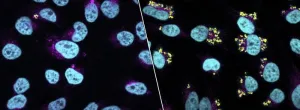(Press-News.org) Nearly one in three people globally unknowingly carries Golden staph, or Staphylococcus aureus, in their nose or on their skin. While the bacterium is harmless to most, it can lead to serious infection and even death if it enters the bloodstream through a cut, surgical wound or catheter.
The major breakthrough, led by the University of Melbourne’s Dr Abdou Hachani, a Senior Researcher at the Peter Doherty Institute for Infection and Immunity (Doherty Institute), published in the online medical journal eLife, was made possible by a new state-of-the-art methodology called ‘InToxSa’. It enables the study of Golden staph behaviour inside human cells on a large scale, with greater efficiency and speed, ultimately accelerating the research process.
Dr Hachani explained the innovative approach, developed by his research team, is key to understanding how Golden staph behaves inside cells and gaining valuable knowledge about the bacteria’s ability to survive and thrive in humans.
“We tested hundreds of S. aureus strains taken from patients with bloodstream infections using InToxSa, and observed specific changes that make the bacteria less harmful and better at surviving in our bodies,” said Dr Hachani.
“We identified the genes that control the bacteria’s ability to persist inside host cells without killing them. This is an important advance to understand how S. aureus can cause lethal infections.”
University of Melbourne’s Professor Tim Stinear, Molecular Microbiologist at the Doherty Institute, explained that the outputs of the platform will guide and inform precision and predictive medicine to treat complicated infections based on the genetic make-up of Golden staph clinical samples.
“InToxSa is a powerful tool that combines genetic analysis, microbiological data and statistical comparisons. It can handle a large volume of data in a systematic and standardised way, which eventually leads to more comprehensive and accelerated scientific discoveries – like ours,” said Professor Stinear.
“Using this platform, we were able to identify mutations in the bacteria that are clinically relevant and promote their ability to persist inside the body. This new knowledge will guide research to find new ways to combat these infections.”
Additional information:
This research was funded by the National Health and Medical Research Council (NHMRC).
DOI: https://doi.org/10.7554/eLife.84778 END
Scientists discover how Golden staph hides and thrives in human cells using state-of-the-art research tool
Researchers have discovered how Golden staph, a common bug that can cause one of the most serious bacterial infections, hides inside human cells to avoid detection by the immune system
2023-06-15
ELSE PRESS RELEASES FROM THIS DATE:
Massive underwater plateau near Solomon Islands is younger and its eruption was more protracted than previously thought, research suggests
2023-06-15
CORVALLIS, Ore. – The Ontong Java Plateau, a volcanically-formed underwater plateau located in the Pacific Ocean north of the Solomon Islands, is younger and its eruption was more protracted than previously thought, new research led by Oregon State University suggests.
The findings, just published in Science, also cast doubt on long-held assumptions that the formation of the plateau, which is roughly the size of Alaska, was the cause of a global deposit of black shale throughout the world’s oceans.
“This type of shale is formed when there is very limited oxygen in the ocean. This layer was formed about 120 million years ago and can be found preserved ...
Prenatal exposure to phthalates may impact future fertility differently in males and females, animal study finds
2023-06-15
Prenatal exposure to chemicals called phthalates, which are used in hundreds of products, may lead to hormonal changes in females that could affect their future fertility, suggests a study in mice being presented Thursday at ENDO 2023, the Endocrine Society’s annual meeting in Chicago, Ill.
The study found female mouse embryos exposed to phthalates during gestation had lower testosterone levels than those not exposed to the chemicals. Immediately after birth, female mice exposed to phthalates during gestation had lower levels of the hormone estradiol than those not exposed.
“These changes in hormone levels ...
Limiting opioids during surgery may lead to more postoperative pain and opioid use for patients
2023-06-15
BOSTON – Because of the opioid crisis, physicians are less likely to administer opioids to help manage patients’ pain, even in the operating room.
A recent analysis in JAMA Surgery that was conducted by investigators at Massachusetts General Hospital (MGH), a founding member of Mass General Brigham, indicates that overly restricting use of opioids during surgery may be doing more harm than good.
For the study, researchers analyzed information on 61,249 adults who had surgery at MGH from 2016–2020. Patients administered more of the ...
HaoSheng Sun named a Freeman Hrabowski scholar by the Howard Hughes Medical Institute
2023-06-15
BIRMINGHAM, Ala. – HaoSheng Sun, Ph.D., assistant professor in the University of Alabama at Birmingham Department of Cell, Developmental and Integrative Biology, has been named to the inaugural class of Freeman Hrabowski scholars by the Howard Hughes Medical Institute.
The 31 new scholars from 22 U.S. institutions are all outstanding early career faculty in science who have the potential to become leaders in their research fields, as well as advance diversity, equity and inclusion through their mentorship and understanding of the experiences of trainees from races and ethnicities that are underrepresented in U.S. ...
Low food security linked to metabolic syndrome in reproductive-aged Latinx females
2023-06-15
CHICAGO—Not having reliable access to food has a significant relationship with metabolic syndrome, a condition that increases risk for diseases such as diabetes and heart disease, in Latinx females of reproductive age, according to a study presented Friday at ENDO 2023, the Endocrine Society’s annual meeting in Chicago, Ill.
“Because of the significant association identified between low food security and metabolic syndrome in reproductive-aged Latinx females, there is potential to reduce cardiovascular, metabolic and reproductive adverse outcomes through improved ...
BMI alone may not be a sufficient indicator of metabolic health
2023-06-15
CHICAGO—Body mass index (BMI) is not a complete measure of metabolic health, and a high proportion of U.S. adults with normal BMI still have obesity, according to research being presented Friday at ENDO 2023, the Endocrine Society’s annual meeting in Chicago, Ill.
The latest research highlights the importance of including what percentage of the body is fat, muscle, bone, and water, and how much fat is in the abdomen vs. the thighs to fully understand drivers for cardio-metabolic disease.
“We show that there are racial/ethnic differences in body ...
Some breast cancer treatments may limit effectiveness of weight loss medications
2023-06-15
Breast cancer medications, called aromatase inhibitors, may lessen the effect of weight loss drugs, according to a new study being presented Friday at ENDO 2023, the Endocrine Society’s annual meeting in Chicago, Ill.
The study found that weight loss medications are less effective in breast cancer survivors who are treated with aromatase inhibitors, compared with women without a history of breast cancer who are not taking aromatase inhibitors.
Aromatase inhibitors are used to treat some types of breast cancer or to keep it from coming back. They may also be used to help prevent breast cancer in some women who are ...
CGM alarms often not set to alert children with diabetes to harmful blood glucose fluctuations
2023-06-15
Children and teenagers who use continuous glucose monitors (CGM) to manage diabetes often fail to use the appropriate alarm settings to alert to dangerously low or harmful high blood sugar levels, according to a study being presented Thursday at ENDO 2023, the Endocrine Society’s annual meeting in Chicago, Ill. This variability makes the monitors less useful in tracking glucose levels.
Children with diabetes employ a large range of CGM alarm settings and cutoffs, many of which differ significantly from recommended values. ...
Astrocyte processing of serotonin regulates olfactory perception
2023-06-15
To enjoy the scent of morning coffee and freshly baked cookies or to perceive the warning smell of something burning, the brain needs two types of cells, neurons and astrocytes, to work closely with each other. Research has shown a great deal of the changes that occur in neurons during olfactory, or smell, perception, but what are the astrocyte responses and how they contribute to the sensory experience remains unclear.
Researchers at Baylor College of Medicine and collaborating institutions report in the journal Science the responses of astrocytes to olfactory stimulation, revealing ...
Close up on aging reveals how different cell types in the body age at different pace
2023-06-15
As the body ages, organ function progressively declines and the risk for a wide range of diseases, including cardiovascular disease, cancer and neurodegenerative diseases, increases. Understanding how the body ages is an intense area of research as it will potentially illuminate ways to promote healthy aging.
Researchers at Baylor College of Medicine, Chan Zuckerberg Biohub San Francisco, Genentech, Inc. and collaborating institutions are breaking a path in that direction. They report in the journal Science, the first Aging Fly Cell Atlas (AFCA), ...
LAST 30 PRESS RELEASES:
Climate policies can backfire by eroding “green” values, study finds
Too much screen time too soon? A*STAR study links infant screen exposure to brain changes and teen anxiety
Global psychiatry mourns Professor Dan Stein, visionary who transformed mental health science across Africa and beyond
KIST develops eco-friendly palladium recovery technology to safeguard resource security
Statins significantly reduce mortality risk for adults with diabetes, regardless of cardiovascular risk
Brain immune cells may drive more damage in females than males with Alzheimer’s
Evidence-based recommendations empower clinicians to manage epilepsy in pregnancy
Fungus turns bark beetles’ defenses against them
There are new antivirals being tested for herpesviruses. Scientists now know how they work
CDI scientist, colleagues author review of global burden of fungus Candida auris
How does stroke influence speech comprehension?
B cells transiently unlock their plasticity, risking lymphoma development
Advanced AI dodel predicts spoken language outcomes in deaf children after cochlear implants
Multimodal imaging-based cerebral blood flow prediction model development in simulated microgravity
Accelerated streaming subgraph matching framework is faster, more robust, and scalable
Gestational diabetes rose every year in the US since 2016
OHSU researchers find breast cancer drug boosts leukemia treatment
Fear and medical misinformation regarding risk of progression or recurrence among patients with breast cancer
Glucagonlike peptide-1 receptor agonists and asthma risk in adolescents with obesity
Reviving dormant immunity: Millimeter waves reprogram the immunosuppressive microenvironment to potentiate immunotherapy without obvious side effects
Safety decision-making for autonomous vehicles integrating passenger physiological states by fNIRS
Fires could emit more air pollution than previously estimated
A new way to map how cells choose their fate
Numbers in our sights affect how we perceive space
SIMJ announces global collaborative book project in commemoration of its 75th anniversary
Air pollution exposure and birth weight
Obstructive sleep apnea risk and mental health conditions among older adults
How talking slows eye movements behind the wheel
The Ceramic Society of Japan’s Oxoate Ceramics Research Association launches new international book project
Heart-brain connection: international study reveals the role of the vagus nerve in keeping the heart young
[Press-News.org] Scientists discover how Golden staph hides and thrives in human cells using state-of-the-art research toolResearchers have discovered how Golden staph, a common bug that can cause one of the most serious bacterial infections, hides inside human cells to avoid detection by the immune system



